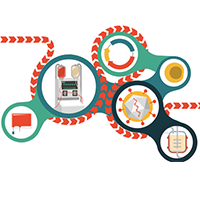Advances in Enabling Smart Technologies across the Cell Therapy Supply Chain
Cell Gene Therapy Insights 2018; 4(5), 495-500.
10.18609/cgti.2018.050
Your research at Imperial focuses on developing computational tools and supply chain concepts for the healthcare industry. Can you explain your research in more detail, especially the aspects relevant to developing the supply chain of advanced therapies?
The project falls under the umbrella of the Future Targeted Healthcare Manufacturing Hub, which is an EPSRC-funded initiative aiming to address several issues around manufacturing, business and supply chain, as well as the regulatory challenges, that arise in the space of targeted biological medicine. At Imperial, we focus on the optimization of supply chain logistics for CAR T cell therapies – a truly transformative, breakthrough modality that will change the treatment of cancer. Our main objective is to significantly decrease the cost of these therapies, whilst ensuring they are delivered to patients in the shortest possible time.
Central to this project’s outcomes, any suggestions we make to improve a process step or procedure must embrace the criticality of the patient condition and the dominant role that time plays because, for these patients, even an hour can make a difference. It’s also essential that any solutions ensure that the industry can sustainably scale up by a factor of 10 to 100.
It’s fundamental to understand all process steps in depth, including their limitations, in order to be able to design novel solutions that will be truly applicable. Therefore, we start by making a detailed map of the vein-to-vein supply chain, documenting all materials used at every step, as well as challenges that arise during the lifecycle of the therapy.
We’re also investigating capabilities and bottlenecks of global logistics models that are currently in place for CART, testing their performance with larger patient populations and at increased scale. I’d like to mention that one of our key objectives is to identify the switching point at which manufacturers need to shift to a more global supply chain model, based on uncertain level of demand.
We also investigate the performance of different supply chain configurations with the aim of identifying the optimal number and locations of clinical manufacturing sites.
So to sum up: the objective of the research here is to design mathematical tools that will assist pharma supply chain decision making processes. These tools will allow the user to run various scenarios, to investigate how the supply chain model will change, and to ascertain how this will impact profit and time-to-market.
How has the supply chain of cell and gene therapies evolved over the past decade, and to what extent have we succeeded in implementing smart technologies in the supply chain?
In the past decade, cell and gene therapy markets in general have evolved tremendously, with a rapid increase in the number of clinical trials promising ground-breaking evolution in the treatment of severe and life-threatening diseases. And on the topic of ground-breaking evolution, in the case of autologous therapies, we’re talking about a completely different business model – one where the product needs to be traced throughout the manufacturing journey up to and including delivery to the patient.
As a result, the pharma business model in the cell and gene business space is radically changing towards more patient-driven and patient-specific approaches, requiring significant advances on current state-of-the-art technology.
In recent times, we’ve seen the emergence of cloud-based applications that assist greatly in advanced supply chain models in the pharmaceutical industry. Ten years ago, there was no commercial supply chain tool that could handle products that were as complex as autologous therapies. Yet in 2018, we see quite a few supply chain orchestration technologies and platforms available. These usually offer seamless management of a series of events that take place and allow maintenance of the chain of identity and custody throughout the supply chain. In terms of tracking, they usually assign a unique identification number to the sample, ensuring anonymity and data safety.
Now, if you’re asking me to what extent those tools are actually applied today, I would say that we are not quite there yet… Small steps have been made towards the digitalisation of the pharma industry supply chain, but I think we’re still far from a fully cloud-based system. QA tends to be very manual as well, and concerns mainly arising from cyber security, data safety and anonymity pose challenges in the shape of a change of mindset for supply chain practitioners – that’s what is slowing the current rate of progress.
Industry 4.0 is gaining increasing momentum in the field – can you give us a brief overview of this digitized, data-driven system? How will it support the cell therapy supply chain?
Industry 4.0 introduces autonomous computerized processes to manufacturing. It usually utilises artificial intelligence (AI) and the Internet of Things (IoT) to facilitate and maintain internal communication within factories.
Aside from Industry 4.0, some are also talking about Pharma 4.0, which is the application of Industry 4.0 in pharmaceutical manufacturing. I must say that the pharmaceutical industry has been amongst the forerunners in the field, adopting digitalised process which can lead to improved efficiency and increased profits.
The adaptation of digitalisation in pharma manufacturing will also be key for symbiotic change across the supply chain, as it will allow connectivity of processes, products and people. And the IoT can also assist with real-time monitoring of storage conditions, which are critical for sensitive pharmaceutical products with shorter shelf-lives, thus improving drug safety. Lastly, real-time tracking and continuous monitoring of manufacturing equipment and personnel will reduce time-to market for final products.
In the particular example of CART, sample tracking is of course imperative to ensure the right therapy is delivered to the right patient. In addition, given the fact that patient conditioning needs to take place at an appropriate time prior to the administration of the treatment, it is essential to know the status of manufacturing in real-time. So this is a journey that we need to follow closely, not only from the side of the manufacturer, but also from the side of the doctor who will reassure the patient that everything is in order.
So Pharma 4.0 could assist greatly in the advancement of supply chain logistics in the personalized therapy space. It will provide a safer place to store and track important product information. In addition, information is stored about the efficacy of the therapy after delivery, which provides a further opportunity to learn and to improve.
What are some of the challenges that remain for a truly Industry 4.0 supply chain to be achieved within the advanced therapies sector?
We need to be honest here – it’s true to say that the logistics part of the supply chain remains quite slow in adapting to and implementing digitalised procedures.
So I think the biggest challenge is a change of mindset, really: if supply chain practitioners truly realized the benefits that arise from the application of Pharma 4.0 in the supply chain, they would see it as an ally and not an underlying threat. Replacing those paper-based systems with cloud-based servers requires a lot of effort, but it will significantly improve both agility and productivity in pharma sector operations.
Right now, though, we are seeing a little of the mindset that sees digitalisation as a threat potentially lead to automated solutions and associated job losses. However, automation is only coming here to replace repetitive tasks, allowing people to have more time to be creative, to redesign and optimize procedures. And of course, we need humans in charge of the automated systems.
Another reason why I think pharma has historically been cautious in adopting novel technologies is the stringent regulatory environment in which it operates. Usually, changes introduced to the process or product, or both, need to be registered and approved by regulators. That consequently imposes additional challenges to the adaptation of new methods and technologies.
And as I mentioned before, cloud-based digital systems inevitably raise concerns relating to data safety, cyber security and patient anonymity, so we definitely need to address these aspects in order to enjoy a smoother, faster adaptation to the Pharma 4.0 concept.
Could you explain in a little more detail how enabling smart technologies can help in achieving a reduction in the Cost of Goods?
Cell and gene therapies have shown promising results for the treatment for various diseases and so it’s likely that this market is facing further rapid growth. This means it’s imperative for the industry to have advanced technologies in place and to be prepared to handle the continued growth in demand. Regardless of stage of product lifecycle, the application of novel technologies can significantly decrease both time-to-market and Cost of Goods.
Advanced automated technologies usually offer real-time tracking and monitoring, minimising risk of failure and optimizing the use of raw materials. From a supply chain perspective, the use of smart technologies such as digital applications for sample tracking allows for seamless product tracking and assists the scheduling of tasks throughout the product lifecycle.
Looking to the future, where do you feel the opportunities for innovation lie in the supply chain? And how do you feel the field will evolve in the next 5-10 years?
I feel we’re actually right at the beginning of a long period of sustained growth in the cell and gene therapy logistics space, which is definitely exciting!
The scene is going to changed radically over the next 5 years, becoming more digital as pharma embraces the concept of Pharma 4.0.
I think that the application of cloud-based systems and orchestration platforms can and will allow shorter delivery times and safer products. But quite apart from the digital side, I believe that future innovations will take place within the supply chain model itself – as we move towards personalized medicine and widespread autologous therapies, supply chain models will have to adapt to be fit for purpose.
Pharma needs to re-think not only the use of paper-based solutions, but also the one-size-fits-all model that is currently in place. Undoubtedly, it won’t be an easy transition, but the key for me lies in using advanced techniques that will allow supply chain practitioners to come up with the right model. Such tools should be of a computational nature – mathematically-driven models that are able to predict the behaviour of supply chains under various scenarios. By embracing and applying such tools, I believe the pharma industry will become more agile and receptive to change, and will significantly decrease risk in its decision-making processes.
Affiliation
Maria Papathanasiou, PhD
Research Associate
Department of Chemical
Engineering,
Imperial College London,
London, UK
This work is licensed under a Creative Commons Attribution- NonCommercial – NoDerivatives 4.0 International License.


